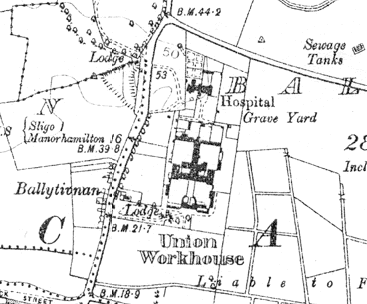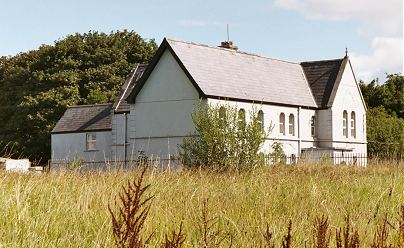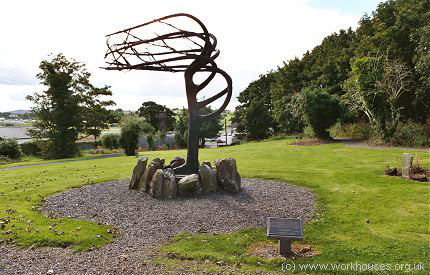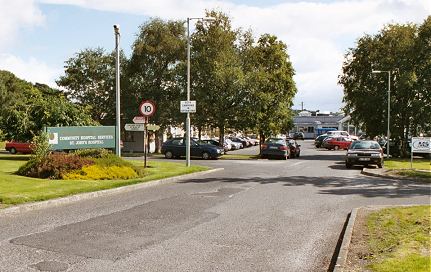Sligo, Co. Sligo
Sligo Poor Law Union was formally declared on the 17th July 1839 and covered an area of 398 square miles. Its operation was overseen by an elected Board of Guardians, 39 in number, representing its 23 electoral divisions as listed below (figures in brackets indicate numbers of Guardians if more than one):
Co. Sligo: Ballintogher, Ballymote (2), Ballynakill, Ballysadare (2), Calry, Carney, Cliffony (2), Cloonacool, Cloonoghill, Coolaney (2), Coolooney (2), Dromard, Drumcliff (2), Drumfin (2), Lissadill (2), Kilmacowen, Knocknarea, Riverstown, Rossinver, Skreen (2), Sligo (6), Templeboy, Tobercurry (3).
The Board also included 13 ex-officio Guardians, making a total of 52. The Guardians met each week on Saturday.
The population falling within the Union at the 1831 census had been 109,561 with divisions ranging in size from Cloonoghill (population 2,241) to Sligo itself (15,518).
The new Sligo Union workhouse was erected in 1840-2 on a nine-acre site a mile to the north of Sligo. Designed by the Poor Law Commissioners' architect George Wilkinson, the building was based on one of his standard plans to accommodate 1,200 inmates. Its construction cost £9,100 plus £1,900 for fittings etc. The workhouse was declared fit for the reception of paupers on 16th November 1841 and received its first admissions on the 17th December.
The workhouse site location and layout are shown on the 1910 map below.

Sligo workhouse site, 1910.
The buildings followed Wilkinson's typical layout. An entrance and administrative block at the south contained a porter's room and waiting room at the centre with the Guardians' board room on the first floor above. The 1910 map shows a separate lodge, possibly a later addition.
The main accommodation block had the Master's quarters at the centre, with male and female wings to each side. At the rear, a range of single-storey utility rooms such as bakehouse and washhouse connected through to the infirmary and idiots' wards via a central spine containing the chapel and dining-hall.
During the famine in the mid-1840s, sheds were erected in the infirmary yards to accommodate 70 inmates. A separate fever hospital was erected at the north of the site.

Sligo fever hospital from the south-west, 2003
© Peter Higginbotham.
The workhouse graveyard lay to the north-west. A memorial now stands to those buried there.

Sligo graveyard, 2003
© Peter Higginbotham.
In 1852, the south-western part of the Sligo Union went to form part of the new Tubbercurry Union, and the western part joined the new Dromore West Union.
From 1899, the Sisters of Mercy provided the nursing staff in the workhouse infirmary.
In 1895, Sligo was visited by a "commission" from the British Medical Journal investigating conditions in Irish workhouse infirmaries. Their report listed a number of deficiencies including overcrowded wards, poor sanitation, and insufficient trained nurses. Further details are available in the full report.
After the creation of the Free State in 1922, the workhouse became a County Home for the aged and infirm, and also acted as the medical section of the County Hospital. The site became known as St John's Hospital and the original workhouse structures were gradually replaced. Only the former fever hospital building now (2003) remains.

Sligo former workhouse site from the west, 2003
© Peter Higginbotham.
Records
Note: many repositories impose a closure period of up to 100 years for records identifying individuals. Before travelling a long distance, always check that the records you want to consult will be available.
- Sligo County Library, Stephen Street, Sligo.
Bibliography
- Crossman, V (2006) Politics, Pauperism and Power in Late Nineteenth-century Ireland
- Gray, P (2009) The Making of the Irish Poor Law, 1815-43
- O'Connor, J (1995) The Workhouses of Ireland
Links
- None.
Unless otherwise indicated, this page () is copyright Peter Higginbotham. Contents may not be reproduced without permission.


